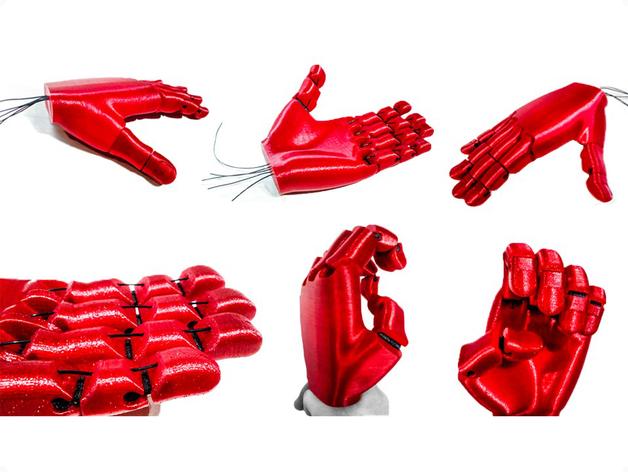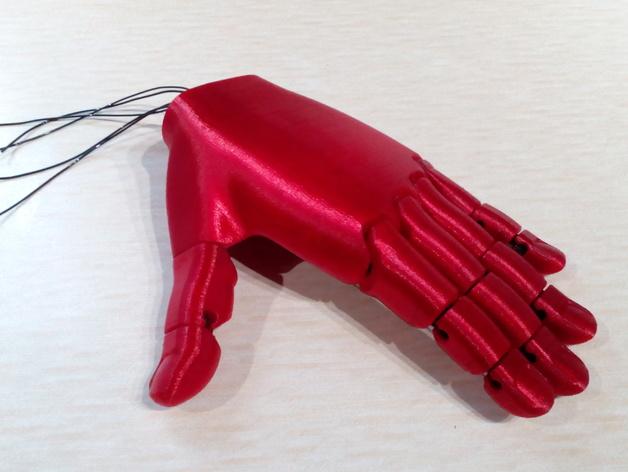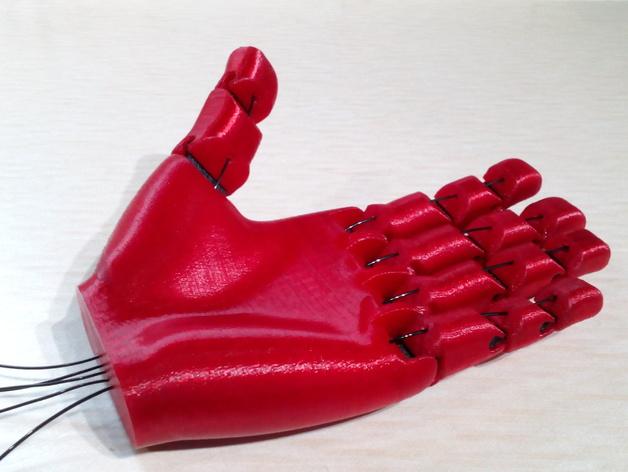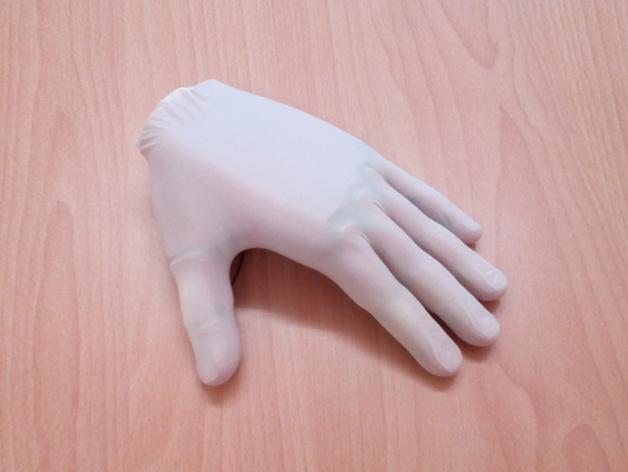When it comes to 3D Printed prosthetics, we have seen dozens of great stories over the past year alone. The RoboHand project is probably the most well known, but there are plenty of others out there as well. There have been prosthetic finger tips, ears, noses and legs created using 3D printing. This has brought cheap, well working alternatives to those individuals who can not afford the ridiculously high costs of traditional prosthetics. The best part is, that many of these projects are open source, meaning that anyone can modify and improve upon them.
One man, by the name of Steve Wood has taken the idea of 3D printing prosthetics to new level. We are used to seeing 3D printed robotic hands that look… well… quite “robotic”. Wood, however, the founder of a mechanical design consultancy company called Gyrobot Ltd., has create a new type of prosthetic hand, using very unique ideas. He calls the design the “Flexy-Hand“.
His hand looks very much like a real human hand. Even more impressive though, is that it also operates much like a human hand. By using Filaflex flexible filament, Wood has made a hand that is like nothing else that we have seen before.
“I have to say the idea is all mine, but the inspiration to make something different comes from many of the other prosthetics out there, which generally use traditional pin style hinge joints,” Wood explained to 3DPrint.com. “Wherever there is a fastener, there is always a chance it becomes an un-fastener, and works itself loose, so screws/nuts and bolts should be avoided wherever possible. Especially in an application such as rotational hinge pins. Also “vitamins” (non-3D printed parts) are items that need to be sourced at the right sizes, which isn’t always possible in some locations. The flexible hinges in my design can be printed at the right size first hit (hopefully) on the same 3D printer. This also makes a tool free assembly possible.”
Wood used his expertise as an engineer and CAD designer to perfect his prosthetic hand to work very much like a human hand.
Like a human hand, the Flexy-Hand uses tendons to operate each finger individually. These tendons are made out of strips of Filaflex, and work surprisingly well. In fact, with a simple motor added to this design, it should work very well to grasp and pick up objects.
“The stretchable Filaflex tendons mimic our own tendon structure where they will stretch for a given amount and then reach their elastic limit and stop,” said Wood. “At that limit, this stuff is so strong that I have yet to break a tendon with all my own force, it just hurts my own hands, maybe I am just really feeble? So I could see a simple robotic actuation method utilising a single motor/servo to pull all the tendons together as a bunch, when an individual fingers touches an item the tendon will continue to stretch whilst the other fingers continue to be activated by the motor to grip the object too. I call this “adaptive grip”. This adaptive grip with single motor couldn’t be used for gesturing or individual finger movements, you would need actuation for each finger for that, but it does make it simpler to implement, maintain and programme with a simple on off switch.”
The tendon assembly is very easy. Once the hand is printed, the 1.75mm Filaflex filament is stretched to its max to reduce its thickness. It is then tied off at the fingertips and threaded down tubes in each finger before exiting out of the hand.
The Flexy-Hand really makes a lot of strides in the world of 3D printed prosthetics. Some of the advantages include the follow, as pointed out by Wood.
- Fingers open automatically, no return tendons or springs needed.
- “Frictionless” articulation – no rubbing parts.
- Stretchable tendons offering adaptive grip on irregular objects (only one motor required to activate all fingers).
- Fully printable solution, no vitamins required.
- Tough and rugged.
- Realistic form under a surgical glove (see images).
In order to mimic biology even moreso, Wood suggests putting a surgical glove on the hand. This gives the hand a skin-like look and feel, and also improves on the gripping ability.
The Flexy-Hand is completely open source with a non-commercial license. This should give a lot of designers a chance to completely customize the hand for whoever may need it. It will also allow people to tinker with different ways of powering the tendons.
All in all, the Flexy-Hand took Wood approximately 20 hours to design, and another 20 hours to print out. He used an Orca 0.43 from Mendel Parts to print the hand, but most printers that can print using Filaflex should do a decent job. Wood printed the hand on 3 plates. One contained the hand body, another the finger joints, and the third contained the flexible hinges. Depending on the size of the hand being printed, print times could vary.
“I am a big advocate of the open-source movement and I hate the current patent model, which I feel is restrictive,” said Wood. “I truly believe it stifles innovation. Just look at what has happened in the 3D printing explosion since 2009 as evidence to see what ideas the open-source movement can unlock.”
Wood would not give us a clear answer as to whether he has additional plans for the Flexy-Hand, but we feel he has something up his sleeve.
“I could give the game away but it would spoil the surprise,” joked Wood. “It is a little technological challenge (for me) but I would like to give it a go.”
There is absolutely no doubt that Steve Wood’s Flexy-Hand will go on to help make many amputees’ lives quite a bit easier. The added fact that his design is open-source will help allow for improvements, advancements and personalization of the hand. Be sure to leave comments for Wood in his forum thread on 3DPrintBoard.
Subscribe to Our Email Newsletter
Stay up-to-date on all the latest news from the 3D printing industry and receive information and offers from third party vendors.
You May Also Like
Gorilla Sports GE’s First 3D Printed Titanium Cast
How do you help a gorilla with a broken arm? Sounds like the start of a bad joke a zookeeper might tell, but it’s an actual dilemma recently faced by...
Nylon 3D Printed Parts Made More Functional with Coatings & Colors
Parts 3D printed from polyamide (PA, Nylon) 12 using powder bed fusion (PBF) are a mainstay in the additive manufacturing (AM) industry. While post-finishing processes have improved the porosity of...
$25M to Back Sintavia’s Largest Expansion of Metal 3D Printing Capacity Since 2019
Sintavia, the digital manufacturing company specializing in mission-critical parts for strategic sectors, announced a $25 million investment to increase its production capacity, the largest expansion to its operations since 2019....
Velo3D Initiates Public Offering in a Bid to Strengthen Financial Foundations and Drive Future Growth
Velo3D (NYSE: VLD) has been among a number of publicly traded 3D printing firms that have attempted to weather the current macroeconomic climate. After posting a challenging financial report for 2023,...



































